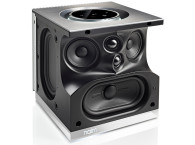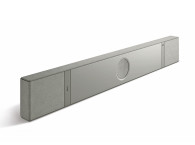
The KEF LS50 Meta was measured at Warkwyn’s facility using the Klippel Near-Field Scanning (NFS) system (Photo 1). The NFS delivers a 360º acoustical radiation balloon allowing for an examination of the radiation pattern, on- and off-axis frequency response at any angle or distance, and any directionally important information, which may help when determining where to place this coaxial speaker into your listening environment.
For the measurements of the LS50, a calibrated ACO Pacific free-field microphone with the 4048 pre-amp and a 7052E capsule were used. All on- and off-axis data is referenced at 1m for sensitivity (2.83V), and then increased to 3m for some evaluations in the listening field.
Measurement points around the speaker totaled 1800 and were processed with a resolution of 18 points per octave and from 20Hz to 20kHz. The length of the stimulus was 0.90 seconds with an average of 4.

Sensitivity
The LS50 Meta comes with a port plug, so one of the initial measurements was an assessment of the plug’s effect on frequency response with and without the port plug. Figure 1 shows that result on-axis and at 1W/1m.
With the port open, the LS50 provides a 1dB increase in amplitude at 140Hz and offers an approximate 1/6 of an octave gain in low-frequency response below 100Hz, and an increased benefit 10dB down from 60Hz to 40Hz. That being the case, the results of our measurements here will be based on the port being plugged as this is the default configuration in which Warkwyn received the speakers.
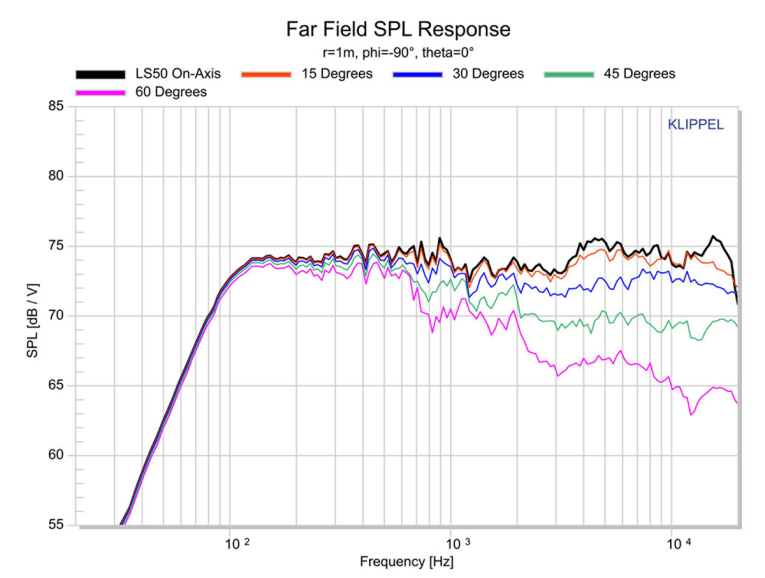
Horizontal On- and Off-Axis Frequency Measurements
Examining the frequency curve on-axis, the LS50 has an impressively smooth response from 135Hz up to 3kHz. Please note the Y-axis, 5dB scale, which translates into a 2dB range of unsmoothed deviation within these frequencies. At 3.5kHz, we see a 3dB rise ending at 10kHz, where the frequency response gradually descends 2.5dB ending at 11kHz. Another peak is then encountered at 16kHz where the device rolls off to its measurement limitations.
Taken as a whole, the complete frequency response exhibits a 2dB variation throughout most of the range, with a dip that spans 1.75 octaves, from 1kHz to 3.5kHz. This might result in a slight reduction in definition, but considering the -1dB to -2dB in level, and the increase at 4kHz, sibilance doesn’t suffer greatly.
Examining the off-axis frequency response curves at 15º; this co-axial system holds together admirably (Figure 2). Even 30º offaxis, the frequency response holds together very well.


Horizontal and Vertical Contour Maps
The unwrapped horizontal contour map is an examination of the frequency to radiation strength in a “top-down” fashion (Figure 3). As the head moves to the left (or down), it is moving to the left around the speaker until the point it reaches the -180º position on the X-axis and behind the speaker. As it moves right (or up in the graphic), it is experiencing the frequency response and radiation around the right side of the speaker.
As a co-axial system, frequency response on-axis is very good from 18kHz down to 3kHz and for a 40 degrees angle. At 3kHz, a 2dB to 3dB dip in frequency response is encountered but this recovers at 1.5kHz.
The radiation pattern is good up to 30 degrees off- axis and to a 6dB down point. This should result in an even and relatively wide listening widow though the vocal region. Another slight dip in response is encountered from 250Hz down to 150Hz where the pressure level recovers and then drops off gradually to 40Hz. Again, this analysis is based upon the ports being closed on the system. With the ports open, an additional 1dB to 2dB in gain is encountered at 40Hz. The beauty of a coaxial system is the symmetry from horizontal to vertical. The vertical contour map below bears this out (Figure 4).
Here we are examining the vertical cross-section from the perspective of the left side of the cabinet. As the head moves up, we are going up and over the cabinet, and conversely down underneath the cabinet and to the back at 180 degrees.
The frequency response is almost identical to the horizontal radiation map with the exception of an asymmetrical loss between 100Hz and 180Hz and at -100º. This would indicate a perceptual difference in low frequency, say kick drum or bass, from sitting on axis to standing and at 3 meters. Of course, your room influence will compensate for some of this difference and, accounting for the CEA 2034 vertical listening window, fall well within 10º. At these same frequencies, the system is quite even from left to right as seen in the horizontal mapping. Figure 5 details the CEA 2034 results.
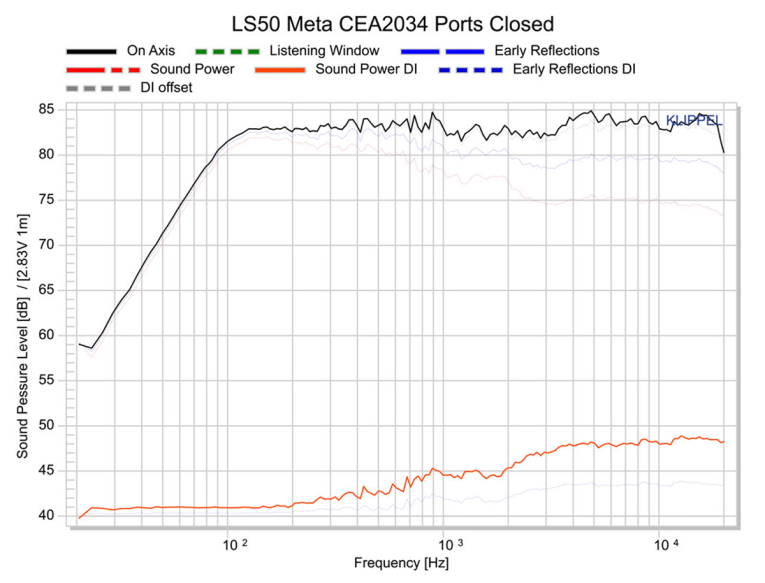
CEA 2034 Results
CEA 2034 defines the listening window as an average response of nine frequency response curves within the 10º vertical and 30º horizontal angular range. As we have illustrated with the on- and off-axis measurements, the LS50 Meta has a respectable frequency response within these ranges. On-axis, the system has a slight 2dB dip between 1kHz and 3.5kHz. This is not improved in the listening window. However, there is 1dB to 2dB reduction in frequency response from 3.5kHz to 10kHz, which provides further smoothing. And the bump found on the on-axis curve at 16kHz is reduced in the listening window 2dB resulting in an over-all smoother response that the single on-axis frequency response illustrates.
The Sound Power DI confirms the LS50’s higher directivity from 1kHz and upward. Ultimately, the CEA 2034 assesses the LS50 Meta as a well performing system within the listening window and in a “typical listening room.”
Listening and Commentary
In our usual nocturnal fashion, Oliver Masciarotte and I met in a dark alley on November, Friday the 13th (!) to heft a Cambridge Audio Edge W for amplification, and the KEFs to enjoy some time listening at 8VB Recording in downtown Minneapolis. The DAC used was a Presonus Studio 192 running at 24-bit/192kHz via Oliver’s Anticables Level 3.1 speaker cables. We were joined by Peter Quirsfeld, owner of young fresh ears and drummer/percussionist for the lovely band Humbird.
8VB typically monitors with powered Neumann KH120s (5.25”/1” dome tweeter two-way) as well as larger, powered Presonus Sceptre 8’s (8”/1” compression driver coaxially mounted in 90 90 horn). Size-wise, the KH120s were similar to the LS50s so that was our go-to for comparison. The KEFs were placed on the outside of the KH120s, and the KH120s were on their side with tweeters on-axis and positioned to the outside of the woofer (Photo 2).
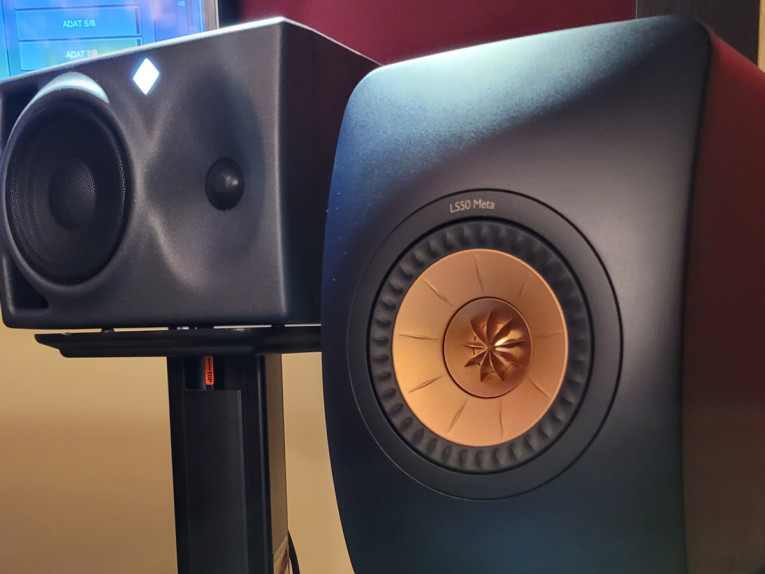
The Listening Experience
The listening position is centered between the systems, at tweeter ear height and within 2 meters from the speakers. To be fair, the mix position at 8VB is not your “typical” listening environment as it is a recording studio control room with plenty of absorption behind the speakers, as well as laterally in the room. Immediately behind the listening position is a comfortable leather couch with 6´x6´ RPG Skyline diffuser on the rear wall.
Above the listening position, a 2´ deep x 4´ x 6´ absorptive cloud hangs. Additionally, the NC of the room approaches 20. So, while not typical, nicely controlled and very quiet.
Listening spanned the gambit from Blue Note jazz, to hard rock, pop, and some ambient. Each of us, Oliver, Peter, and I spent a considerable amount of time right on-axis. During my time on center, I resorted to some of my go-to recordings — Thomas Dolby both old and new due to his always tight bass and sub structure and beautifully recorded piano and vocals; some Stan Getz to hear the definition of his stark and dry sax; and some recordings I am currently working on to assess the differences between what I hear in a mix between the KEFs and the Neumanns.
During times either sitting on the couch or standing and moving left to right within the mix space, I found the KEFs to be very similar to the Neumanns especially in the high-frequency from 1kHz and up to 3kHz. The boost in frequency response of the KEFs however, from 3.5kHz to 10kHz, was very apparent when switching back and forth. This created a perceived clarity I wasn’t necessarily hearing from the KH120s. This was confirmed by both Peter and Oliver while on-axis and moving side to side.
Low-frequency output of the KEF’s was good. However, when switching back and forth to the Neumanns, there was a noticeable low-frequency improvement with the Neumanns with greater overall output and depth. Thankfully, I realized that I had some Klippel measurement data on the Neumann KH120s that I could use in comparison to the measured KEFs. Figure 6 shows that measurement comparison. After examining the comparison curves my listening impressions were confirmed.
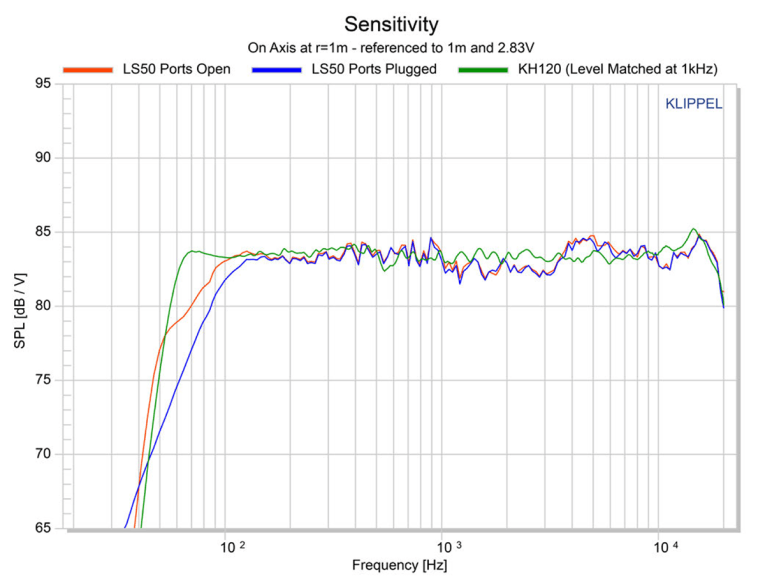
The KH120 has greater low-frequency “extension” than the LS50’s even with the ports open. The rise in response from 3.5kHz to around 9kHz of the KEFs, resulted in a greater impression of clarity and certainly brightness. Not unpleasing but clearly audible in comparison to the Neumanns. Again, we were listening in an acoustically treated room intended for accuracy. In a “typical” environment and as illustrated in the CEA 2034 curves, this would be diminished with harder reflections.
As we packed up for the evening, we were all quite impressed with the KEFs. For me in particular, not only did I like how they sounded, I also love the physical presentation. They feel fantastic and are quite striking. For a week I struggled with how I could hide them from my wife until a time I could honestly tell her “Oh, those old things? I’ve had them forever.” Kudos KEF for some great sounding and gorgeous looking speakers, I really enjoyed them. aX
This article was originally published in audioXpress, June 2021.
 About the Author
About the AuthorKent Peterson is sneaking up on 30 years in the Pro Audio and Acoustics field. Having designed hundreds of audio systems for professional install and approximately 100 miles of noise walls, Peterson now spreads sawdust on employee “accidents” managing Warkwyn in Saint Paul, MN.
Read the first part of the audioXpress KEF LS50 Meta review, written by Oliver Masciarotte.





